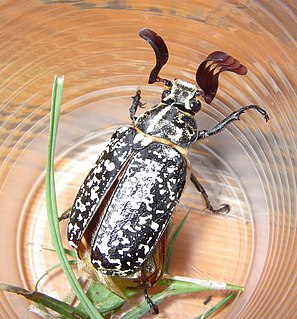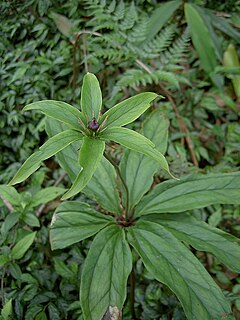
A forest is an area of land dominated by trees. Hundreds of definitions of forest are used throughout the world, incorporating factors such as tree density, tree height, land use, legal standing and ecological function. The Food and Agriculture Organization defines a forest as land spanning more than 0.5 hectares with trees higher than 5 meters and a canopy cover of more than 10 percent, or trees able to reach these thresholds in situ. It does not include land that is predominantly under agricultural or urban land use. Using this definition FRA 2020 found that forests covered 4.06 billion hectares or approximately 31 percent of the global land area in 2020 but are not equally distributed around the globe.

Reforestation is the natural or intentional restocking of existing forests and woodlands (forestation) that have been depleted, usually through deforestation, but also after clearcutting.

An old-growth forest – also termed primary forest, virgin forest, late seral forest or primeval forest – is a forest that has attained great age without significant disturbance and thereby exhibits unique ecological features and might be classified as a climax community. The Food and Agriculture Organization of the United Nations defines primary forests as naturally regenerated forests of native tree species where there are no clearly visible indications of human activity and the ecological processes are not significantly disturbed. More than one-third of the world’s forests are primary forests. Old-growth features include diverse tree-related structures that provide diverse wildlife habitat that increases the biodiversity of the forested ecosystem. Virgin forests are old-growth forests that have never been logged. The concept of diverse tree structure includes multi-layered canopies and canopy gaps, greatly varying tree heights and diameters, and diverse tree species and classes and sizes of woody debris.

In biology, the canopy is the aboveground portion of a plant croping or crop, formed by the collection of individual plant crowns.

Amomyrtus is a genus of flowering plants in the myrtle family, Myrtaceae described as a genus in 1948. It is native to temperate southern South America, where it is distributed in Chile and Argentina.

Dyera is a genus of tropical trees up to 80 m in height. They are in family Apocynaceae, native to southeast Asia. It was first described as a genus in 1882, by Joseph Dalton Hooker.

In botany, a tree is a perennial plant with an elongated stem, or trunk, supporting branches and leaves in most species. In some usages, the definition of a tree may be narrower, including only woody plants with secondary growth, plants that are usable as lumber or plants above a specified height. In wider definitions, the taller palms, tree ferns, bananas, and bamboos are also trees. Trees are not a taxonomic group but include a variety of plant species that have independently evolved a trunk and branches as a way to tower above other plants to compete for sunlight. Trees tend to be long-lived, some reaching several thousand years old. Trees have been in existence for 370 million years. It is estimated that there are some three trillion mature trees in the world.

Polyphylla is a genus of scarab beetle includes more than 80 species distributed in North and Central America, southern and central Europe, northern Africa, and southern Asia—from Asia Minor to Japan. They typically reside in forests and orchards with most being identified by white elytra scales forming stripes. The adult beetles are often attracted to lights. Polyphylla lay their eggs on soil near plants from where the larvae hatch and burrow down to the roots on which they will feed. They reach maturity in two to three years.

Bukit Duabelas is a relatively small national park covering 605 km² in Sumatra, Indonesia. It is representative of lowland tropical rain forests in the province of Jambi. Only the northern part of the park consists of primary rainforest, while the rest is secondary forest, as result of previous logging. The park is inhabited by the indigenous Orang Rimba.
The Death Valley June beetle is a scarab beetle in the subfamily Melolonthinae. It is only known to occur in the drainage basin of the Amargosa River in the southwestern United States. Saltgrass communities, such as those at Saratoga Springs in Death Valley, provide habitat for the insect at all stages of its life.

Polyphylla fullo is a beetle belonging to the family Scarabaeidae, subfamily Melolonthinae.

The Phu Langka Forest Park, or Phu Lang Ka Forest Park, is a protected area of the Phi Pan Nam Range located in Chiang Kham District and Pong District, Phayao Province, Thailand. The park was established on May 8, 2002 and covers an area of 12.48 km².

Paris polyphylla is an Asian species of flowering plant native to China, Taiwan, the Indian Subcontinent, and Indochina. It produces spider-like flowers that throw out long, thread-like, yellowish green petals throughout most of the warm summer months and into the autumn. In the fall, the flowers are followed by small, scarlet berries. It is a perennial, which slowly spreads, is fully hardy in Britain, and survives in leafy, moist soil in either complete or partial shade.
Helicia excelsa is a plant in the family Proteaceae. It grows as a tree up to 20 metres (70 ft) tall, with a trunk diameter of up to 25 centimetres (10 in). The bark is dark grey to blackish. Inflorescences bear up to three reddish brown flowers. Fruit is black, ellipsoid, up to 3 centimetres (1 in) long. The specific epithet excelsa is from the Latin meaning "lofty", referring to the tree's growth. Habitat is forests from sea level to 1,700 metres (5,600 ft) altitude. H. excelsa is found in Bangladesh, Burma, Thailand, Malaysia and Indonesia.
Helicia fuscotomentosa is a plant in the family Proteaceae. It grows as a tree up to 25 metres (80 ft) tall, with a trunk diameter of up to 30 centimetres (12 in). The bark is mottled grey and black. The flowers are reddish brown. Its habitat is forests from sea level to 2,000 metres (6,600 ft) altitude. H. fuscotomentosa is endemic to Borneo.
Helicia pterygota is a plant in the family Proteaceae. It grows as a shrub or small tree up to 7 metres (20 ft) tall, with a stem diameter of up to 6 centimetres (2 in). The bark is brownish. The specific epithet pterygota is from the Greek meaning "winged", referring to the pedicel. Habitat is forests from 1,000 metres (3,300 ft) to 1,800 metres (6,000 ft) altitude. H. pterygota is endemic to Borneo where it is confined to Mount Kinabalu in Sabah.
Heliciopsis velutina is a species of trees, in the family Proteaceae. They grow up to 25 metres (80 ft) tall, with a trunk diameter of up to 25 cm (10 in). The bark is dark brown. They have reddish brown flowers. They have brown, ellipsoid fruits up to 4 cm (2 in) long. The specific epithet velutina comes from the Latin meaning "velvety", referring to the petiole. They grow naturally in lowland mixed dipterocarp forests' habitats from sea level to 600 metres (2,000 ft) altitude in Peninsular Malaysia and Borneo.

The Japurá-Solimões-Negro moist forests (NT0132) is an ecoregion of tropical moist broad leaf forest in the Amazon biome.

The Sumatran freshwater swamp forests ecoregion covers disconnected patches of freshwater swamp forest on the alluvial plains of the island of Sumatra in Indonesia. The different locations vary greatly in their vegetation and wildlife habitat depending on the local soil types. The land has been greatly disturbed by human conversion to agriculture and illegal logging in recent years. Several of the sectors support significant populations of Asian elephants (Elephas maximus)'.

The Southwest Borneo freshwater swamp forests ecoregion covers a number disconnected patches of freshwater swamp forest along the southwestern coasts of Borneo. The swamps are generally set back a few kilometers or two from the sea by the saltwater-affected Sunda Shelf mangroves The relatively fertile, flat soil has led to much of this ecoregion being converted to agriculture.















